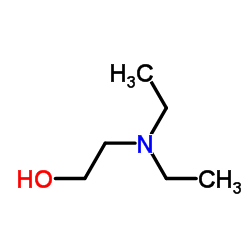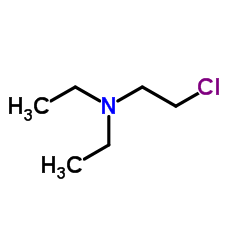14426-20-1
| 中文名 | N,N-二乙基乙醇胺盐酸盐 |
|---|---|
| 英文名 | 2-(Diethylamino)ethanol hydrochloride |
| 中文别名 |
2-二乙基氨基乙醇盐酸盐
二乙氨基乙醇盐酸盐 |
| 英文别名 |
Ethanol, 2-(diethylamino)-, hydrochloride (1:1)
2-diethylaminoethanol hydrochloride EINECS 238-395-9 MFCD00036374 2-(Diethylamino)ethanol hydrochloride (1:1) ethanol, 2-diethylamino-, hydrochloride |
| 密度 | 1.52g/cm3 |
|---|---|
| 沸点 | 478.8ºC at 760mmHg |
| 熔点 | 133°C |
| 分子式 | C6H16ClNO |
| 分子量 | 153.650 |
| 闪点 | 243.4ºC |
| 精确质量 | 153.092041 |
| PSA | 23.47000 |
| LogP | 1.12250 |
| 储存条件 | 常温密闭避光,通风干燥 |
| 稳定性 | 常温常压下稳定 避免的物料:氧化物 |
| 分子结构 | 1、摩尔折射率:无可用的 2、摩尔体积(cm3/mol):无可用的 3、等张比容(90.2K):无可用的 4、表面张力(dyne/cm):无可用的 5、介电常数:无可用的 6、极化率(10-24cm3):无可用的 7、单一同位素质量:153.092042 Da 8、标称质量:153 Da 9、平均质量:153.6503 Da |
| 计算化学 | 1.疏水参数计算参考值(XlogP):无 2.氢键供体数量:2 3.氢键受体数量:2 4.可旋转化学键数量:4 5.互变异构体数量:无 6.拓扑分子极性表面积23.5 7.重原子数量:9 8.表面电荷:0 9.复杂度:43.8 10.同位素原子数量:0 11.确定原子立构中心数量:0 12.不确定原子立构中心数量:0 13.确定化学键立构中心数量:0 14.不确定化学键立构中心数量:0 15.共价键单元数量:2 |
| 更多 | 1. 性状:块状 2. 密度(g/mL,25/4℃):未确定 3. 相对蒸汽密度(g/mL,空气=1):未确定 4. 熔点(ºC):未确定 5. 沸点(ºC,常压):未确定 6. 沸点(ºC,5.2kPa):未确定 7. 折射率:未确定 8. 闪点(ºC):未确定 9. 比旋光度(º):未确定 10. 自燃点或引燃温度(ºC):不适用的 11. 蒸气压(kPa,25ºC):未确定 12. 饱和蒸气压(kPa,60ºC):未确定 13. 燃烧热(KJ/mol):未确定 14. 临界温度(ºC):未确定 15. 临界压力(KPa):未确定 16. 油水(辛醇/水)分配系数的对数值:未确定 17. 爆炸上限(%,V/V):未确定 18. 爆炸下限(%,V/V):未确定 19. 溶解性:未确定 |
|
Section I.Chemical Product and Company Identification Chemical Name 2-Diethylaminoethanol Hydrochloride Portland OR SynonymN,N-Diethylethanolamine Hydrochloride Chemical Formula(C2H5)2NCH2CH2OH•HCl CAS Number14426-20-1 Section II.Composition and Information on Ingredients Chemical NameCAS Number Percent (%)TLV/PELToxicology Data 2-Diethylaminoethanol Hydrochloride14426-20-1 Min. 98.0 (T) Not available.Mouse LD50 (subcutaneous) 1260mg/kg Mouse LD50 (intravenous) 458mg/kg Mouse LD50 (intraperitoneal) 1162mg/kg Section III. Hazards Identification No specific information is available in our data base regarding the toxic effects of this material for humans. However, Acute Health Effects exposure to any chemical should be kept to a minimum. Skin and eye contact may result in irritation. May be harmful if inhaled or ingested. Always follow safe industrial hygiene practices and wear proper protective equipment when handling this compound. CARCINOGENIC EFFECTS : Not available. Chronic Health Effects MUTAGENIC EFFECTS : Not available. TERATOGENIC EFFECTS : Not available. DEVELOPMENTAL TOXICITY: Not available. There is no known effect from chronic exposure to this product. Repeated or prolonged exposure to this compound is not known to aggravate existing medical conditions. Section IV.First Aid Measures Eye ContactCheck for and remove any contact lenses. IMMEDIATELY flush eyes with running water for at least 15 minutes, keeping eyelids open. COLD water may be used. DO NOT use an eye ointment. Flush eyes with running water for a minimum of 15 minutes, occasionally lifting the upper and lower eyelids. Seek medical attention. Treat symptomatically and supportively. Skin ContactAfter contact with skin, wash immediately with plenty of water. Gently and thoroughly wash the contaminated skin with running water and non-abrasive soap. Be particularly careful to clean folds, crevices, creases and groin. COLD water may be used. Cover the irritated skin with an emollient. Seek medical attention. Treat symptomatically and supportively. Wash any contaminated clothing before reusing. InhalationIf the victim is not breathing, perform artificial respiration. Loosen tight clothing such as a collar, tie, belt or waistband. If breathing is difficult, oxygen can be administered. Seek medical attention. Treat symptomatically and supportively. IngestionINDUCE VOMITING by sticking finger in throat. Lower the head so that the vomit will not reenter the mouth and throat. Loosen tight clothing such as a collar, tie, belt, or waistband. If the victim is not breathing, administer artificial respiration. Examine the lips and mouth to ascertain whether the tissues are damaged, a possible indication that the toxic material was ingested; the absence of such signs, however, is not conclusive. Seek immediate medical attention and, if possible, show the chemical label. Treat symptomatically and supportively. Section V. Fire and Explosion Data Not available. FlammabilityCombustible.Auto-Ignition Flash PointsFlammable Limits Not available.Not available. Combustion Products These products are toxic carbon oxides (CO, CO 2), nitrogen oxides (NO, NO2), halogenated compounds. WARNING: Highly toxic HCl gas is produced during combustion. Fire Hazards No specific information is available regarding the flammability of this compound in the presence of various materials. Continued on Next Page 2-Diethylaminoethanol Hydrochloride Risks of explosion of the product in presence of mechanical impact: Not available. Explosion Hazards Risks of explosion of the product in presence of static discharge: Not available. No additional information is available regarding the risks of explosion. Fire Fighting Media SMALL FIRE: Use DRY chemicals, CO 2, water spray or foam. and InstructionsLARGE FIRE: Use water spray, fog or foam. DO NOT use water jet. Section VI.Accidental Release Measures Spill Cleanup In case of a spill and/or a leak, always shut off any sources of ignition, ventilate the area, and exercise caution. Use a shovel to put the material into a convenient waste disposal container. Finish cleaning the spill by rinsing any Instructions contaminated surfaces with copious amounts of water. Consult federal, state, and/or local authorities for assistance on disposal. Section VII. Handling and Storage Handling and StorageKeep away from heat and sources of ignition. Mechanical exhaust required. When not in use, tightly seal the container and store in a dry, cool place. Avoid excessive heat and light. DO NOT breathe dust. In case of insufficient ventilation, Information wear suitable respiratory equipment. If you feel unwell, seek medical attention and show the label when possible. Treat symptomatically and supportively. Avoid contact with skin and eyes. Always store away from incompatible compounds such as oxidizing agents. Section VIII. Exposure Controls/Personal Protection Engineering ControlsUse process enclosures, local exhaust ventilation, or other engineering controls to keep airborne levels below recommended exposure limits. If user operations generate dust, fume or mist, use ventilation to keep exposure to airborne contaminants below the exposure limit. Personal ProtectionSplash goggles. Lab coat. Dust respirator. Boots. Gloves. A MSHA/NIOSH approved respirator must be used to avoid inhalation of the product. Suggested protective clothing might not be sufficient; consult a specialist BEFORE handling this product. Exposure LimitsNot available. Section IX. Physical and Chemical Properties Solubility Physical state @ 20°CPowder.Soluble in cold water, hot water. Not available. Specific Gravity Molecular Weight153.65Partition CoefficientNot available. Boiling PointNot available.Vapor PressureNot available. Melting Point133°C (271.4°F)Vapor DensityNot available. Not available.VolatilityNot available. Refractive Index Critical TemperatureOdorNot available. Not available. Not available.Not available. ViscosityTaste Section X.Stability and Reactivity Data Stability This material is stable if stored under proper conditions. (See Section VII for instructions) Conditions of Instability Avoid excessive heat and light. Incompatibilities Reactive with oxidizing agents. Section XI. Toxicological Information RTECS NumberKK5553400 Routes of ExposureEye contact. Inhalation. Ingestion. Mouse LD50 (subcutaneous) 1260mg/kg Toxicity Data Mouse LD50 (intravenous) 458mg/kg Mouse LD50 (intraperitoneal) 1162mg/kg Chronic Toxic EffectsCARCINOGENIC EFFECTS : Not available. MUTAGENIC EFFECTS : Not available. TERATOGENIC EFFECTS : Not available. DEVELOPMENTAL TOXICITY: Not available. There is no known effect from chronic exposure to this product. Repeated or prolonged exposure to this compound is not known to aggravate existing medical conditions. Acute Toxic EffectsNo specific information is available in our data base regarding the toxic effects of this material for humans. However, exposure to any chemical should be kept to a minimum. Skin and eye contact may result in irritation. May be harmful if inhaled or ingested. Always follow safe industrial hygiene practices and wear proper protective equipment when handling this compound. Continued on Next Page 2-Diethylaminoethanol Hydrochloride Section XII.Ecological Information EcotoxicityNot available. Environmental FateNot available. Section XIII. Disposal Considerations Recycle to process, if possible. Consult your local or regional authorities. You may be able to dissolve or mix material with Waste Disposal a combustible solvent and burn in a chemical incinerator equipped with an afterburner and scrubber system. Observe all federal, state, and local regulations when disposing of this substance. Section XIV. Transport Information DOT ClassificationNot a DOT controlled material (United States). PIN NumberNot applicable. Proper Shipping Name Not applicable. Packing Group (PG)Not applicable. DOT Pictograms Section XV. Other Regulatory Information and Pictograms TSCA Chemical InventoryThis compound is ON the EPA Toxic Substances Control Act (TSCA) inventory list. (EPA) WHMIS Classification Not available. (Canada) EINECS Number (EEC) Not available. EEC Risk StatementsNot available. SECTION 16 - ADDITIONAL INFORMATION N/A |
|
毒理学数据: 1、急性毒性:主要的刺激性影响: 在皮肤上面:刺激皮肤和粘膜; 在眼睛上面:刺激的影响;没有已知的敏化影响。 生态学数据: 通常对水体是稍微有害的,不要将未稀释或大量产品接触地下水,水道或污水系统,未经政府许可勿将材料排入周围环境。 CHEMICAL IDENTIFICATION
HEALTH HAZARD DATAACUTE TOXICITY DATA
|
| 风险声明 (欧洲) | 36/37/38 |
|---|---|
| 安全声明 (欧洲) | S26-S37/39 |
| RTECS号 | KK5553400 |
| 海关编码 | 2921199090 |
|
~% 
14426-20-1 |
| 文献:Journal of Molecular Catalysis A: Chemical, , vol. 327, # 1-2 p. 45 - 50 |
|
~% 
14426-20-1 |
| 文献:Pharmazie, , vol. 36, # 7 p. 480 - 482 |
| 上游产品 2 | |
|---|---|
| 下游产品 4 | |
| 海关编码 | 2921199090 |
|---|---|
| 中文概述 | 2921199090 其他无环单胺及其衍生物及其盐。监管条件:无。增值税率:17.0%。退税率:9.0%。最惠国关税:6.5%。普通关税:30.0% |
| 申报要素 | 品名, 成分含量, 用途 |
| Summary | 2921199090 other acyclic monoamines and their derivatives; salts thereof VAT:17.0% Tax rebate rate:9.0% Supervision conditions:none MFN tariff:6.5% General tariff:30.0% |







![2,5-双[3-(N,N-二乙基氨基)-1-氧杂丙基]-1,4-二溴苯结构式](https://image.chemsrc.com/caspic/081/233753-19-0.png)

